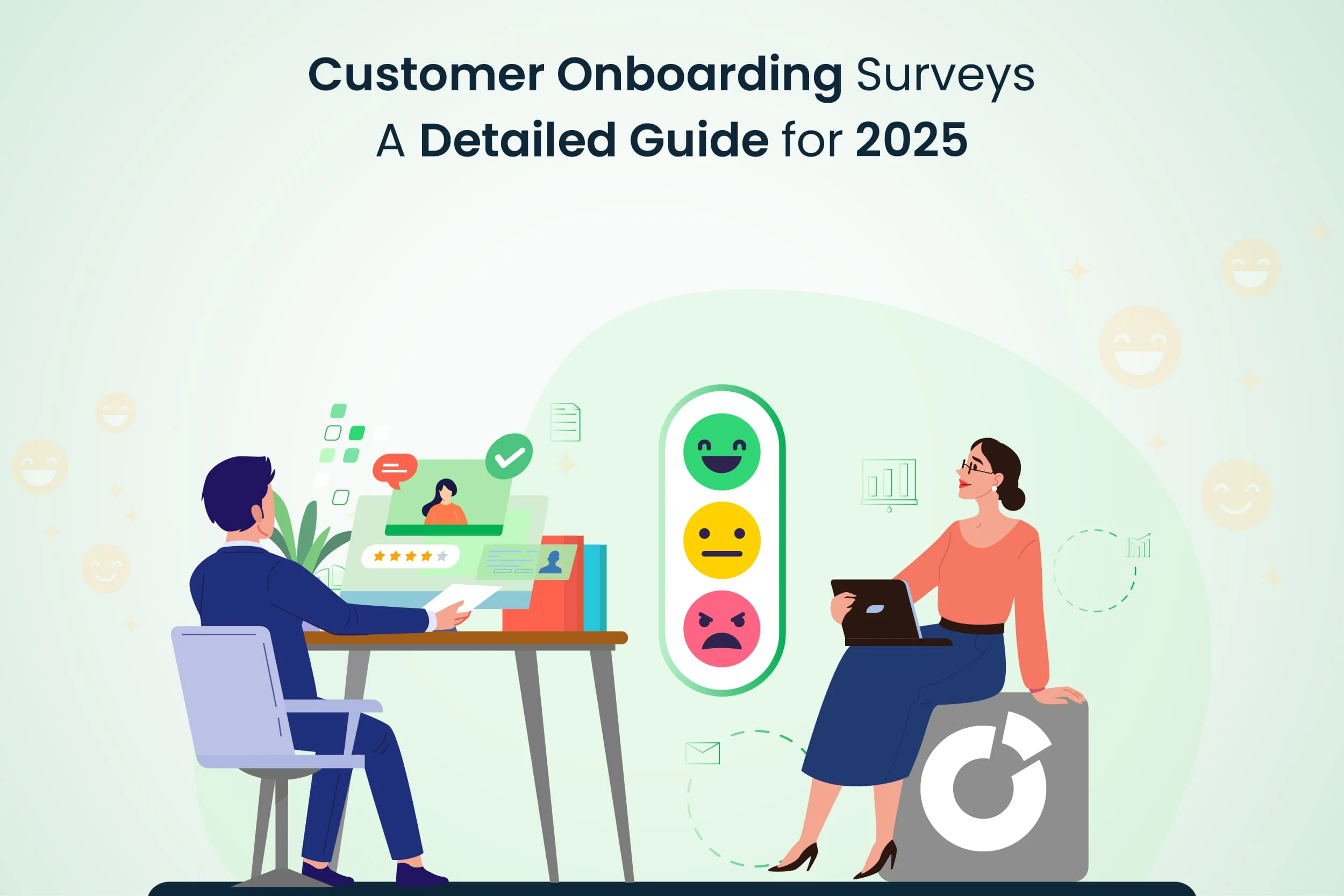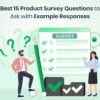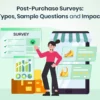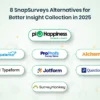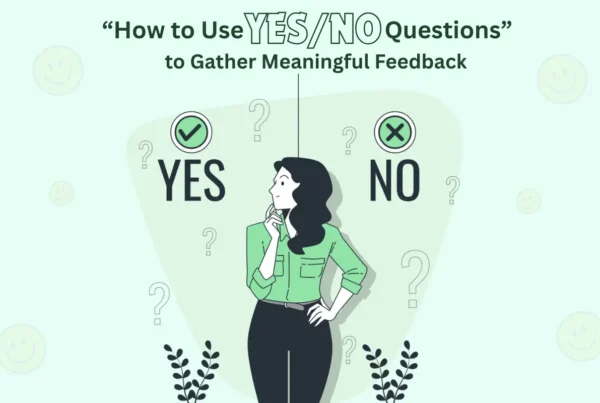Businesses across the globe invest heavily in acquisition, but success truly hinges during onboarding. A well-structured onboarding process will make sure that the customers understand your product or service and can see value. Effective customer onboarding often determines the longevity of customer satisfaction. Customer Onboarding Surveys are the key here and help new customers feel supported and valued right from the start.
This blog post walks through the importance of onboarding surveys, how to craft insightful questionnaire, best practices, and a customizable template to get started.
The Role of Customer Onboarding Surveys
Most onboarding issues related to customers stem from unclear instructions, or lack of timely support. Customer onboarding surveys consist of more than just email chains or guided instructions. The surveys aim to gather responses from recent customers during or shortly after their onboarding experience.
These surveys are crucial in helping businesses determine how the onboarding process fulfills customers’ expectations, as well as confirming the most pressing pain points. Businesses can identify ineffective communication channels, eliminate unnecessary steps, and optimize customers’ journeys to enable them to achieve their goals within the shortest possible time.
But how do you know if your onboarding process is effective? Customer onboarding surveys fulfill this critical function.
Why Feedback Matters in Onboarding?
The feedback about the customer onboarding process supplies a direct method of grasping the user expectations and difficulties. Onboarding is a very important phase that defines a customer’s first contact with your product or service. Customer onboarding feedback assists to
- Gauge satisfaction: Are users understanding the value quickly?
- Uncover barriers: At what points are people getting stuck?
- Make UX better: Which changes would simplify the onboarding?
There is still a big risk of losing customers without any feedback, not to mention the fact that feedback is now very important. Apart from that, feedback allows teams to make their iterations more efficient, thus making sure the onboarding process changes in accordance with customers’ needs.
Crafting Effective Onboarding Survey Questions
Survey questions for onboarding must be clear, simple and directly related to obtaining practical insights. The main emphasis should be on a customer onboarding experience, clarity of the directions, and the value that they feel.
Here are some onboarding survey questions and the category they serve:
Expectations
- Did the onboarding process meet your expectations? (Yes/No + follow-up)
- What aspect of the onboarding process exceeded or fell short of your expectations?
Goal Oriented
- What’s your primary goal for using [product]?
- How confident are you in achieving that goal with our tool? (Scale 1–10)
- Was there any feature or resource that would have helped you achieve your goal faster?
Overall Satisfaction
- How would you rate your onboarding experience overall? (1–5 stars)
- What’s one thing we could improve?
- Did the onboarding experience make you feel confident in using the product independently?
When creating a questionnaire, think about the consumer’s experience. To give an example, finding out what features were used during the onboarding process can indirectly indicate if the customers are interacting with the main functionalities of the product.
A question such as “Which feature did you find most intuitive?” not only will help to identify the good points to go deeper into
Structuring Surveys for Maximum Engagement
A well-designed survey strikes a balance between briefness and comprehensiveness so that it can elicit a high level of response. Summarize the survey. Take advantage of multiple-choice, rating scale, and open-ended questions to elicit a range of responses.
Lengthy surveys tend to cause respondents to drop out before completion which distorts the collected feedback. The survey duration should remain brief while collecting vital information about the onboarding process.
The survey response rate will increase when you place feedback forms inside product interfaces by triggering pop-ups after important user actions instead of depending only on email distribution. When users provide feedback immediately after using the product their responses become both more precise and pertinent.
When to Send a Customer Onboarding Survey?
Timing is everything. The best moment to send a survey is when the onboarding experience is fresh. Here are a few strategies to consider sending an onboarding survey:
- Right after first product/service usage.
- After the first support interaction.
- At the end of a formal onboarding session or walkthrough.
Best Practices for Customer Onboarding Surveys
To get the most out of your customer onboarding surveys, follow best practices:
- Personalize surveys by addressing customers by name or referencing their specific product use case.
- Offer incentives, like discounts or gift cards, to boost response rates.
- Close the Feedback Loop. Let customers know how their feedback influenced changes.
- Compare results monthly or quarterly to spot patterns and improvements.
- Leverage technology to automate survey distribution and analysis, using tools to streamline the process.
Layering survey results by customer segment ensures that unique needs of clients are uncovered so that onboarding can be customized to speak specifically to any given audience. That approach instills trust, onboarding strategy, and customer satisfaction.
Ready-to-Use Customer Onboarding Survey Template
A standard onboarding survey questions template makes it easy to create customer onboarding surveys. Here is a 5-question template you can use to gather feedback:
Questions:
- On a scale of 1–10, how easy was it to get started?
- What was the most helpful part of the onboarding process?
- Did anything cause confusion or delay?
- How confident do you feel using [product/service] right after onboarding?
- Is there anything we could do to make this experience better?
Addressing Common Onboarding Pain Points
Recurring problems are often identified through customer onboarding feedback. The real value lies in turning feedback into action. Taking the lead and going beyond simple survey replies by exploring the core issue, making adjustments in the training, and spotting trends across various customers and thus focusing the fixing part in the roadmap can make the onboarding experience better.
Measuring the Impact of Surveys
Retention, activation, and Net Promoter Score (NPS) of customers are all useful insights to evaluate the impact of the surveys. Also, assessing metrics before and after the survey displays the return on investment of feedback efforts, demonstrating value of resources spent improving the customer onboarding experience.
As businesses collect and analyze feedback over time they adjust marketing, product development and customer success strategies to make the customer journey seamless from start to finish.
How does piHappiness turn customer onboarding into informed action?
piHappiness is a customer focused platform that takes a new approach to turning feedback into insights throughout the onboarding process. By connecting the dots between onboarding feedback and long-term customer satisfaction, piHappiness helps businesses understand how the changes they make during onboarding influence overall retention, engagement, and NPS scores.
This enables businesses to see how effective each onboarding update is and if the changes really do make a difference. Ultimately this leads to a more refined onboarding journey and better user adoption and satisfaction.
Conclusion
Onboarding is the first real interaction a potential customer has with the business. Customer Onboarding surveys have the capability of providing valuable information to further enhance the customer experience during onboarding. From well-thought-out and targeted survey questions, businesses can develop impeccable and straightforward onboarding experiences that uphold high satisfaction from the customer’s side and hence, their loyalty.
Listening to your customers from day one makes all the difference.
